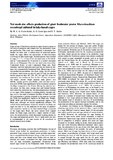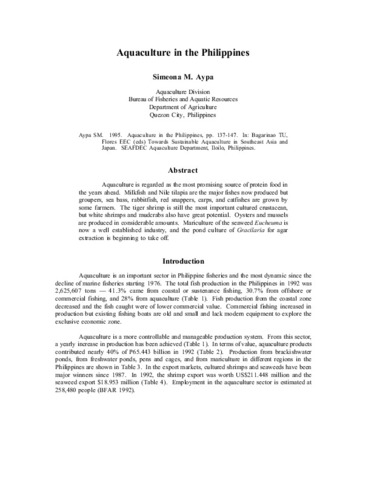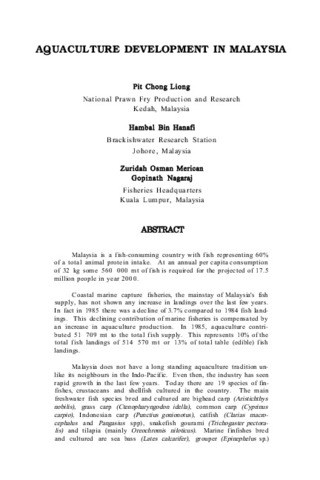Culture of Macrobrachium rosenbergii (De Man 1879) in experimental cages in a freshwater eutrophic lake at different stocking densities
- Global styles
- MLA
- Vancouver
- Elsevier - Harvard
- APA
- Help

View/Open
Date
2007Page views
2,622ASFA keyword
AGROVOC keyword
Taxonomic term
Geographic names
Metadata
Perlihat publikasi penuhCited times in Scopus
Share
Abstract
Macrobrachium rosenbergii (de Man 1879) juveniles (0.4 g) were cultured in experimental cages (L × W × H: 2.5 × 1 × 1 m) in Laguna de Bay, the largest lake in the Philippines. The following stocking densities at four replicates each were used: 15, 30, 60 and 90 prawns m−2 of cage bottom. The mean sizes at harvest after 5 months of culture ranged from 14.3 g for the highest stocking density to 26.3 g for the lowest. The mean size at harvest, daily growth rate and size class distribution were significantly influenced by stocking density, with those at the lowest stocking density showing significantly better growth and overall proportion of larger prawns. Heterogeneous individual growth (HIG) was fairly evident in all treatments. The percentage of blue-clawed males was not influenced by treatment but the mean weight was significantly higher in the lower stocking densities. Both the percentage and mean weight of berried females were significantly higher in the lowest stocking density. Survival was the highest in the lower stocking densities (55.3%, 54.0%, 52.7% and 36.9% for 15, 30, 60 and 90 prawns m−2 respectively). Feed conversion ratio (FCR) improved with decreasing stocking density, ranging from 2.1 to 3. As expected, yield per cropping increased with stocking density and ranged from 450 to 1089 g m−2 yr−1 of actual cage area. Production values obtained in the cage cultured M. rosenbergii were comparable to or even higher than those reported from pond culture, given that the stocking densities used in this study were generally higher than in ponds. The results show that the farming of M. rosenbergii in cages in lakes is a viable alternative to pond culture and has the potential of improve aquaculture production in lakeshore fish farming communities.
Keywords
cage culture giant freshwater prawn Laguna de Bay Philippines lake culture Macrobrachium rosenbergiiSuggested Citation
Cuvin-Aralar, M. L., Aralar, E. V., Laron, M. A., & Rosario, W. (2007). Culture of Macrobrachium rosenbergii (De Man 1879) in experimental cages in a freshwater eutrophic lake at different stocking densities. Aquaculture Research , 38(3), 288-294. https://doi.org/10.1111/j.1365-2109.2007.01667.x
Type
ArticleISSN
1355-557XKoleksi
- Journal Articles [1247]
Related items
Showing items related by title, author, creator and subject.
-
Net mesh size affects production of giant freshwater prawn Macrobrachium rosenbergii cultured in lake-based cages
Cuvin-Aralar, M. L. A.; Lazartigue, A. G.; Aralar, E. V. (Wiley, 2013)Cage culture of freshwater prawns in open waters is prone to the entry of predators and competitors that particularly hamper production. This study was conducted to determine how smaller net mesh sizes to reduce entry of ...22 Total citations1 Recent citation0.27 Field Citation Ration/a Relative Citation Ratio
-
Aquaculture in the Philippines
Aypa, Simeona M. (Aquaculture Department, Southeast Asian Fisheries Development Center, 1995)Aquaculture is regarded as the most promising source of protein food in the years ahead. Milkfish and Nile tilapia are the major fishes now produced but groupers, sea bass, rabbitfish, red snappers, carps, and catfishes ... -
Aquaculture development in Malaysia
Liong, Pit Chong.; Hanafi, Hambal Bin.; Merican, Zuridah Osman.; Nagaraj, Gopinath. (Aquaculture Department, Southeast Asian Fisheries Development Center, 1988)Malaysia is a fish-consuming country with fish representing 60% of a total animal protein intake. At an annual per capita consumption of 32 kg some 560 000 mt of fish is required for the projected of 17.5 million people ...






